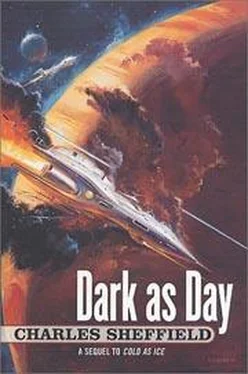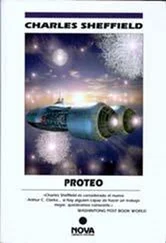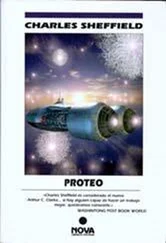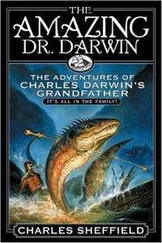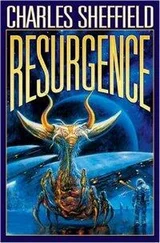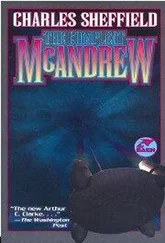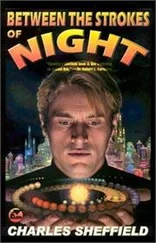Jan nodded again and glared at Sebastian, who said, “Yep.”
“Very well. So be it.” Dr. Bloom collected the files and stood up. “That will be all.”
“Thank you.” The words stuck in Janeed’s throat, and she had to swallow and start over. “Thank you for letting us try. Will we be allowed to try again?”
“I think not.” Maybe Dr. Valnia Bloom was a sadist, or maybe she had been trained not to show feelings, because she had an odd little smile on her face. “There will be no second try.”
“Yes, ma’am.”
“However, as I understand it, you are both required to give two weeks notice for service with General Minerals. I suggest that you do so immediately. Two and a half weeks from now there will be places reserved for you on a passenger shuttle. Once in a micro-gravity environment you will undergo complete physical examinations, after which a high-acceleration transit vessel will take you to Ganymede. Formal indoctrination will begin there.”
She was heading up the steep ladder that led back to the main platform. Halfway up, she ducked her head and turned to where Janeed and Sebastian sat stunned at the little table.
“I should mention one other thing of interest. You took the test three weeks ago. Correct?”
“Yes, ma’am.”
Those sketches that Sebastian made at that time. They closely resemble actual storms on Saturn. But you did not copy them.”
“No, sir.” Sebastian spoke firmly for the first time. “I mean, no, ma’am. I said already, I didn’t copy them.”
“My last remark was not a question but a statement. I know that you did not copy images forwarded to Earth, for the best of all possible reasons.” Valnia Bloom was at the top of the stairs when she added, “You could not have. The storm system that you drew did not appear on the face of Saturn until ten days ago.”
4
THE BAT CAVE, PANDORA, YEAR 2097, SEINE-DAY MINUS ONE
At about the time when Dr. Valnia Bloom spread before Sebastian Birch his sketches of Saturnian clouds and asked about their origins, Rustum Battachariya was in a position to take a look at the real thing. All he had to do was walk twenty paces to the end of the Bat Cave. Then he could ride an ascending elevator to an observation chamber on Pandora’s surface, float forward in the negligible gravity of the tidally-locked little moon, and stare down on the vast rings and broad face of Saturn itself.
Not, of course, that Bat had the least intention of doing any such thing. He never went near the surface, and anyway he was busy. He and his software tools were locked in combat with one of the most formidable intelligences in the Solar System, and if things went well the fight would continue for the next ten or twelve hours. The nearest actual humans were maybe a million kilometers away, observing the Von Neumanns at work on Saturn’s giant moon, Titan. That suited Bat fine. He neither needed help, nor wanted it.
The decision to move the Bat Cave from Ganymede’s deep interior had not been made lightly. Bat had worked there, productively and misanthropically and generally ignored, for more than fifteen years. Then, four years ago, the worst thing possible had happened: he had made a trip to Europa to resolve a mystery, and in the course of his visit the existence of an alien life form in Europa’s deep ocean had been revealed. It was nothing like the distant intelligences sought by Jack and Philip Beston in their SETI projects, merely a curious aperiodic crystal with the ability to reproduce and with a minimum of internal metabolism. But it was enough. Enough to have Europa placed off-limits for development, and enough for something else. A member of the media — the invasive, intrusive, inquisitive, insatiable, intolerable media — had been present on Europa, and Nell Cotter in her report had fingered Bat as the hero of the whole incident. The name, shaved black cannonball head, and three-hundred-kilo body of Rustum Battachariya became famous throughout the Solar System. Ail hope of privacy was lost.
After that, almost daily, some media wretch would employ a combination of bribery and bare-faced lies to discover the location of the Bat Cave. They would then seek out Bat and plead for exclusive interviews.
Four months of this was more than Bat could stand. He began the search. Where to go?
At first there was a temptation to move inward. Following the ending of the Great War, Earth had become the Sol-ward limit of human existence. The research station on Mercury and the research domes on Venus had been utterly destroyed. Bat could have gone there. But both Mercury and Venus had substantial surface gravity, and Bat, although tolerant of Ganymede’s weaker pull, wanted less weight rather than more. As bad or worse, as the System steadily recovered, so the urge to rebuild lost resources grew. Scientific pressure was increasing for a station on Venus and Mercury. If that happened, in the whole Inner System there was nowhere else to go. You had four planets and three moons, and no wiggle room.
Bat turned his analytical eye outward. The habitable Jovian satellites thrummed with life and daily became more crowded. You had to look farther, recognizing that no matter what you did today, at some time in the future you might have to make another change. He expected to live a long time. The lesser satellites of Uranus or even of Neptune were not beyond consideration.
He made his decision, he made his plans, and when all was ready he resigned his position as head of Passenger Transport Schedules for the Outer System. He revealed where he was going only to his boss, Magrit Knudsen, first obliging her to swear that she would never contact him, visit him, or reveal his whereabouts to any living soul. And then he relented. Magrit Knudsen had provided protective cover for Bat for more than a dozen years. She could, he said, contact him if she was in personal difficulty. Or — an afterthought — if someone came to her with an intellectual problem that she deemed worthy of Bat’s powers. He was still a senior member of the Puzzle Network, and he had no intention of abandoning that activity.
Bat arranged to move the whole Bat Cave, complete with its unique contents, to a natural chamber deep within one of Saturn’s minor satellites, Pandora. Everything was handled by machines controlled by Bat alone, and when the operation was finished he used his knowledge of the Ganymede computer systems to erase all records. Then it was time for the final step. Bat had to conquer his own agoraphobia enough to suffer the long journey through open space.
He did it the easy way. He imbibed a carefully mixed combination of hypnagogic drugs, closed his eyes, and opened them to find himself on Pandora.
The moon was an irregular rock splinter fifty kilometers long and thirty across. Compared with Saturn’s nine major moons it was a flyspeck, skimming along underneath them and orbiting the planet in less than a day. Since it was above the great ring systems and had a downward view partly blocked by them, no one would choose it as a preferred site for planetary surveillance. It had no atmosphere, no mineral resources, no natural water or other volatiles. It should have no interest to anyone.
For Bat, however, Pandora seemed perfect. He had no desire for a window seat to examine Saturn, and he would bring his own self-contained habitat, together with ample volatiles to last a century. After that, if necessary, he would review his options.
And so far Pandora had lived up to all of Bat’s expectations. In three full years, he had been plagued by not a single visitor. Magrit Knudsen had contacted him exactly once, when she was faced with a transportation requirement involving an apparently impossible scheduling conflict. Bat embedded the structure within a more general class of problem, provided an algorithm for the whole set, and sent a complete answer to Magrit two days later. He had allowed himself the indulgence of one major gloat before returning to his studies of lost artifacts of the Great War.
Читать дальше
